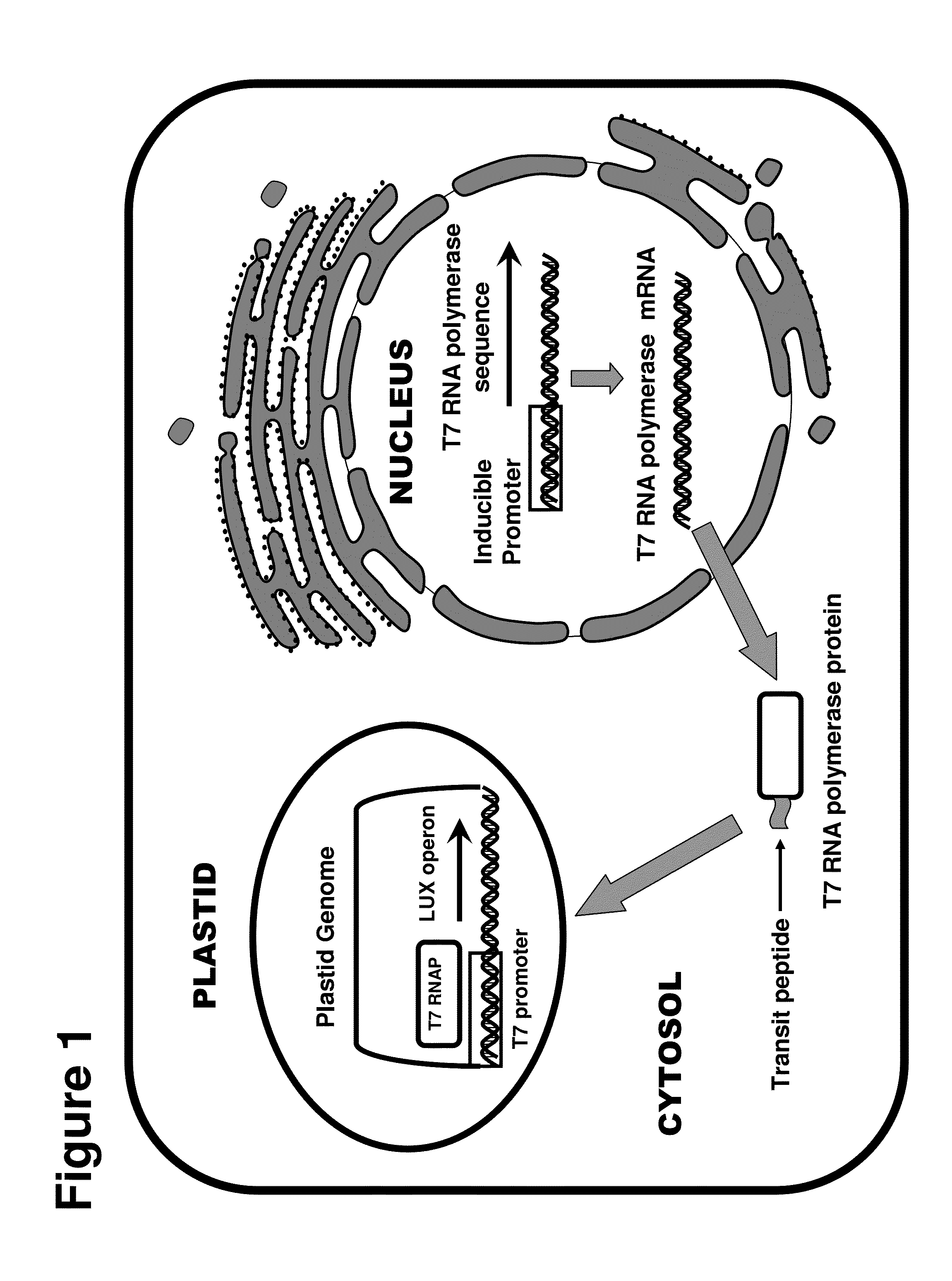Biosensors
- Summary
- Abstract
- Description
- Claims
- Application Information
AI Technical Summary
Benefits of technology
Problems solved by technology
Method used
Image
Examples
example 1
Construction of Chloroplast Transformation Vectors
[0212]In one aspect of the invention, the chloroplast transformation vector has been constructed based on Bioglow's cloning vector pBGL (FIG. 8). The aadA selection marker was PCR amplified using forward 5′-GCTTCCATGGGGGAAGCGGTGATCGCCGAAG-3′ (SEQ ID NO:18) and reverse 5′-GTATGCATGCTTATTTGCCGACTACCTTGGTGATC-3′ (SEQ ID NO:19)
primers and cloned using NcoI / SphI into pBGL. Primers 5′-TTTCCCTCTAGAAATAATTTTGTTTAACTTTAAGAAGGAGATATACCATGGGGGAAG CGGTGATCGCCGAAG-3′ (SEQ ID NO:20) and 5′-CCGTTGTGGTCTCCCTATAGTGAGTCGTATTAATTTCGCGGCGCGCCTACCGGTTTAA AC-3′ (SEQ ID NO:21) were used to PCR the whole vector, followed by self-ligation of the PCR products, and introducing the phage T7 gene 10 promoter (T7g10p) into the construct. Nicotiana tabacum plastidal TpsbA terminator was cloned as a NdeI / PstI PCR fragment amplified using forward 5′-CAGTCATATGATCCTGGCCTAGTCTATAGG-3′ (SEQ ID NO:22) and reverse 5′-CTGTCTGCAGTCGAATATAGCTCTTCTTTCTTATTTC-3′ (SEQ ID NO:23...
example 2
Generation of Autoluminescent Plants
[0214]Plastids of any plant species can potentially be transformed by a chloroplast transformation vector carrying the LUX operon. In this particular instance, we used Nicotiana tabacum (tobacco) plants for demonstration purposes. Transplastomic tobacco plants have been generated according to methods known in the art. Briefly, 0.6 micron gold particles (BioRad) coated with pBGL-T7p-LUX-Tobacco vector DNA were bombarded into leaves of aseptically grown 4-6 weeks old tobacco plants using PDS-1000 / He Biolistic Particle Delivery System (system settings: bombardment He pressure approx. 250 psi above rapture disk pressure, [rapture disks of 1,100 psi were used]; distance from the top of the chamber 9 cm [third slot], chamber vacuum pressure 28 in Hg). The bombarded leaves were incubated at 25-26° C. in dark for 2-3 days and dissected to 5×5 mm squares, which were placed in deep Petri dishes containing 50 ml of RMOP medium (RMOP per liter: MS salts, Cais...
example 3
Generation of Autoluminescnet Phytosensor (ALPS) Plants
[0215]Transplastomic plants produced using pBGL-T7p-LUX-Tobacco as described in Example 2 were used to generate ALPS plants, where T7 RNA Polymerase (T7RNAP) is expressed in the nucleus and the resulting polypeptide is transported to the chloroplast by N-terminal fusion of a transit peptide to activate LUX operon expression. T7RNAP expression can be driven by any promoter in the nucleus. For this example, we chose the drought inducible rd29A of Arabidopsis and constitutive NOS promoters (with NOS-driven T7RNAP plants used as positive control), and binary vectors carrying rd29A-T7RNAP and NOS-T7RNAP have been designated as pDI-rd29A and pDI-PC (Positive Control), respectively. The base vector contained the following expression cassette: AscI-NOS promoter-MCS (SalI-BglII-Sad-EcoRI-KpnI-HindIII-BamHI-PstI-Stul)-NOS terminator. Tobacco ribulose 1,5-bisphosphate carboxylase transit peptide (RbcSTP) was PCR amplified using primers 5′-...
PUM
| Property | Measurement | Unit |
|---|---|---|
| Electrical resistance | aaaaa | aaaaa |
| Size | aaaaa | aaaaa |
| Shape | aaaaa | aaaaa |
Abstract
Description
Claims
Application Information
 Login to View More
Login to View More - R&D
- Intellectual Property
- Life Sciences
- Materials
- Tech Scout
- Unparalleled Data Quality
- Higher Quality Content
- 60% Fewer Hallucinations
Browse by: Latest US Patents, China's latest patents, Technical Efficacy Thesaurus, Application Domain, Technology Topic, Popular Technical Reports.
© 2025 PatSnap. All rights reserved.Legal|Privacy policy|Modern Slavery Act Transparency Statement|Sitemap|About US| Contact US: help@patsnap.com



